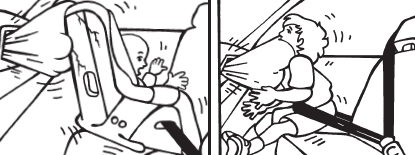 An air bag can save your life. However, air bags and young children are a dangerous combination.
An air bag can save your life. However, air bags and young children are a dangerous combination.
The following information will help keep you and your children safe:
- The safest place for all infants and children younger than 13 years to ride is in the back seat.
- Never put an infant in the front seat of a car, truck, SUV, or van with a passenger air bag.
- All children should be properly secured in car safety seats, belt-positioning booster seats, or the lap and shoulder belts correct for their size.
- All infants and toddlers should ride in a rear-facing car seat as long as possible or until they reach the highest weight or height allowed by their car safety seat’s manufacturer.
- All children who have outgrown the rear-facing weight or height limit for their car safety seat, should use a forward-facing car safety seat with a harness for as long as possible, up to the highest weight or height allowed by their car safety seat’s manufacturer.
- All children whose weight or height is above the forward-facing limit for their car safety seat should use a belt-positioning booster seat until the vehicle seat belt fits properly, typically when they have reached 4 feet 9 inches in height and are between 8 and 12 years of age.
- When children are old enough and large enough to use the vehicle seat belt alone, they should always use lap and shoulder seat belts for optimal protection.
- Side air bags improve safety for adults in side impact crashes, but children who are not properly restrained and are seated near a side air bag may be at risk for serious injury. Check your vehicle owner’s manual to see what it says about children and side air bags.
- New “advanced” air bags make travel safer for adults, but it is not yet known how they will affect the safety of children. Even though these new air bags may be safer, the back seat is still the safest place for children younger than 13 years to ride.

What parents can do:
- Eliminate potential risks of air bags to children by buckling them in the back seat for every ride.
- Plan ahead so that you do not have to drive with more children than can be safely restrained in the back seat.
- For most families, installation of air bag on/off switches is not necessary. Air bags that are turned off provide no protection to older children, teens, parents, or other adults riding in the front seat.
- Air bag on/off switches should only be used if your child has special health care needs for which your pediatrician recommends constant observation during travel and no other adult is available to ride in the back seat with your child.
- If no other arrangement is possible and an older child must ride in the front seat, move the vehicle seat back as far as it can go, away from the air bag. Be sure the child is restrained properly for his size. Keep in mind that your child may still be at risk for injuries from the air bag. The back seat is the safest place for children to ride.
Source: American Academy of Pediatrics, “Air Bag Safety” healthychildren.org website. Accessed February 12, 2020. https://www.healthychildren.org/English/safety-prevention/on-the-go/Pages/Air-Bag-Safety.aspx
© Copyright 2020. All rights reserved. This content is strictly for informational purposes and although experts have prepared it, the reader should not substitute this information for professional insurance advice. If you have any questions, please consult your insurance professional before acting on any information presented. Read more.
